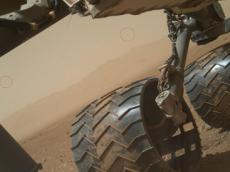|
|
TODAY.AZ / Weird / Interesting
NASA's new question - 'What happened to Mars?'
18 November 2013 [15:04] - TODAY.AZ
 You may have heard it before: billions of years ago Mars probably looked more like Earth does now, with clouds and oceans and a much thicker atmosphere. It may even have had some type of microbes. But now it's a barren, frozen desert.
You may have heard it before: billions of years ago Mars probably looked more like Earth does now, with clouds and oceans and a much thicker atmosphere. It may even have had some type of microbes. But now it's a barren, frozen desert.So what happened? Where did the air and water go?
NASA is launching a new spacecraft to try to find out. It's called MAVEN, which stands for Mars Atmosphere and Volatile Evolution. It's the first mission dedicated to studying the red planet's upper atmosphere.
"We expect to learn how the modern Mars works, really in detail. To see its climate state, to understand how the atmosphere is lost to space -- how Mars may have lost a magnetic field -- to take that information and map it back in time, " said NASA's James Garvin.
The earliest liftoff time for MAVEN is Monday, November 18, at 1:28 p.m. ET from Cape Canaveral Air Force Station in Florida. A United Launch Alliance Atlas V rocket will launch the probe into space on a 20-month trip to Mars. It's scheduled to arrive September 22, 2014.
The solar-powered probe is about the length of school bus -- 37.5 feet (11.43 meters) long -- and will weigh about 5,410 pounds (2,454 kg) at launch.
What killed Mars? New spacecraft will find out
"MAVEN will fill in a very big gap in our understanding of the planet by exploring the upper atmosphere and its influence on the Martian environment," principal investigator Bruce Jakosky, from the University of Colorado, says on his NASA webpage.
He says he's "excited that we're providing one step along the path of answering questions about whether life ever existed on Mars."
Jakosky's team will use the spacecraft's three instrument suites to try to meet three key objectives:
• Determine the composition of upper Martian atmosphere
• Determine how fast Mars is losing what's left of its atmosphere
• Determine the history of the atmosphere
MAVEN won't make a cool, daring landing like the Mars Curiosity Rover, which has been roaming Mars for more than a year now. Instead, it will orbit between a low of about 93 miles (150 kilometers) above the surface to a high of about 3,728 miles (6,000 kilometers). It also will make five dives, flying as low as 77 miles (125 kilometers) in altitude.
NASA says the mission will cost $671 million.
/CNN/
URL: http://www.today.az/news/interesting/128260.html
 Print version
Print version
Views: 1988
Connect with us. Get latest news and updates.
See Also
- 19 February 2025 [22:20]
Visa and Mastercard can return to Russia, but with restrictions - 05 February 2025 [19:41]
Japan plans to negotiate with Trump to increase LNG imports from United States - 23 January 2025 [23:20]
Dubai once again named cleanest city in the world - 06 December 2024 [22:20]
Are scented candles harmful to health? - 23 November 2024 [14:11]
Magnitude 4.5 earthquake hits Azerbaijan's Lachin - 20 November 2024 [23:30]
Launch vehicle with prototype of Starship made its sixth test flight - 27 October 2024 [09:00]
Fuel prices expected to rise in Sweden - 24 October 2024 [19:14]
Turkiye strikes terror targets in Iraq and Syria - 23 October 2024 [23:46]
Kazakhstan supplied almost entire volume of oil planned for 2024 to Germany in 9 months - 23 October 2024 [22:17]
Taiwan reported passage of Chinese Navy aircraft carrier near island
Most Popular
 Azerbaijan, Oman discuss deepening partnership during official talks
Azerbaijan, Oman discuss deepening partnership during official talks
 Azerbaijan strengthens green financing framework for renewable energy projects, says official
Azerbaijan strengthens green financing framework for renewable energy projects, says official
 Locations for new energy storage systems revealed in Azerbaijan
Locations for new energy storage systems revealed in Azerbaijan
 Art Weekend presents exhibition 'In Dew. The Morning That Never Was'
Art Weekend presents exhibition 'In Dew. The Morning That Never Was'
 EBRD supports Azerbaijan in developing national hydrogen energy roadmap
EBRD supports Azerbaijan in developing national hydrogen energy roadmap
 Baku to host VictoryFest-5 Creative Festival
Baku to host VictoryFest-5 Creative Festival
 Pashinyan vs. Etchmiadzin: who is who?
Pashinyan vs. Etchmiadzin: who is who?
